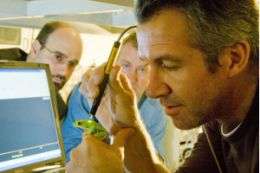Rainforest expedition will shine light on frog deaths

(PhysOrg.com) -- A physicist and a conservationist from The University of Manchester are heading for the rain forests of Costa Rica – in a bid to understand more about a deadly fungus that is killing amphibians around the world.
Physicist Dr Mark Dickinson from the Photon Science Institute and Andrew Gray, Curator of Herpetology at the Manchester Museum are using equipment more commonly used for medical diagnosis to see inside the skin of South American tree frogs.
Infrared reflection spectroscopy and photography does not cause harm or distress and allows images to be obtained from the surface and within the tissue of the frogs
Manchester researchers believe these spectroscopy techniques could hold the key to understanding the alarming global decline in amphibians.
Now the researchers are taking their work outside the lab and into the field. Dr Dickinson, Mr Gray and former Manchester zoology student Stephanie Dawson will spend just over two weeks in Costa Rica.
They will use a stripped down portable version of their usual lab equipment to investigate the skin of tree frogs living in the wild. Dr Mark Dickinson is now busy investigating ways of powering his equipment without electricity.
The Manchester Museum already boasts a large and unique collection of colourful tree frogs. Mr Gray visits Costa Rica every summer and this year he is hoping to find a pair of the extremely rare Isthmohyla rivularis frogs, so they can be brought back to Manchester for breeding, before being released back into the wild.
Tree frogs prefer to live on leaves and branches high above the ground. They enjoy basking in the hot sun, which is unusual because frogs normally avoid prolonged exposure to light due to the risk of overheating and dehydration.
The Manchester team believes global warming is leading to more cloud cover in the tree frogs' natural habitat – and think this is denying them the opportunity to 'sunbathe' and kill off the Chytrid fungus – a fatal infection that is causing many species dying out.
In their work so far, the team have observed the skin of sun bathing tree frogs sometimes undergoes a visible change and becomes almost metallic in texture. They think that when this happens, the level of absorption and reflection and the skin temperature change.
The Manchester team believes that tree frogs are able to bask under a fierce sun because they have the ability to regulate their body temperature and prevent overheating through the unique structure and properties of their skin.
Mr Gray and Dr Dickinson, along with Dr Richard Preziosi from the Faculty of Life Sciences, are seeking further funding to do more comprehensive research using the spectroscopic and OCT techniques.
They want to use it to compare structural changes in the skin of tree frogs with the structural changes in the skin of frogs that do not have the same high levels of infrared reflectance.
Dr Dickinson said: "I had been working on infrared reflection spectroscopy for medical imaging. When Andrew approached me about a possible collaboration, I thought that this would be perfect for the frogs - it can show us what is happening in the frogs' skin but it is non-invasive.
“This is a great example of novel and exciting interdisciplinary research that draws on expertise right across the University."
Mr Gray said: "With a third of the world's amphibians currently under threat it's vitally important we do our utmost to investigate the reasons why they are dying out at such an alarming rate.
"The imaging techniques we use do not harm the frogs in any way. As an animal conservationist, I simply would not allow any research that distressed these amazing creatures."
After arriving in San Jose, the group plan to visit Costa Rican Amphibian Research Centre in Talamanca before trekking into the Monteverde Cloudforest Reserve to begin their search for the Isthmohyla rivularis frog – thought to be extinct until Mr Gray found and photographed it last year. During the hunt the group will spend the night in a basic and remote hut without electricity and running water.
The University of Manchester researchers, whose trip is being funded by the Photon Science Institute, Chester Zoo and The Manchester Museum will be accompanied by staff from the zoo.
Chester Zoo’s involvement reflects its support for the conservation of the Rana Vibicaria frog species, which is only found in the Monteverde Cloudforest Reserve. The zoo and Manchester Museum are the only places in the world currently breeding these frogs.
Provided by University of Manchester

















